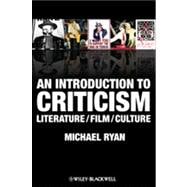
Note: Supplemental materials are not guaranteed with Rental or Used book purchases.
Purchase Benefits
What is included with this book?
Michael Ryan teaches American Literature and Film Studies at Temple University, USA. He is the author of numerous publications, including Literary Theory: An Anthology, second edition (co-edited with Julie Rivkin, Wiley-Blackwell, 2004), Literary Theory: A Practical Introduction, second edition (Wiley-Blackwell, 2007), Cultural Studies: An Anthology (Wiley-Blackwell, 2008), and Cultural Studies: A Practical Introduction (Wiley-Blackwell, 2010).
The New copy of this book will include any supplemental materials advertised. Please check the title of the book to determine if it should include any access cards, study guides, lab manuals, CDs, etc.
The Used, Rental and eBook copies of this book are not guaranteed to include any supplemental materials. Typically, only the book itself is included. This is true even if the title states it includes any access cards, study guides, lab manuals, CDs, etc.